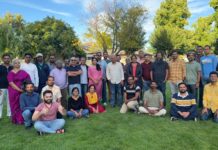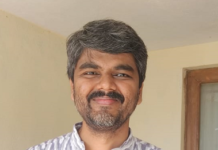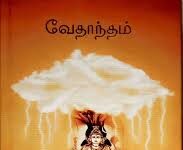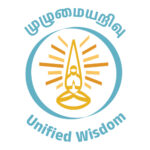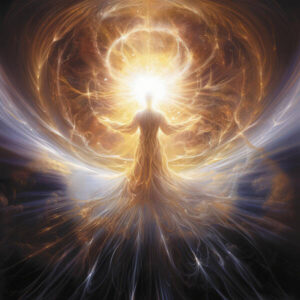
Some time ago, my friends and I were traveling through a small village in the northern part of Tamil Nadu. We happened to overhear a farmer saying, “We have completed the bridal ceremony with all the rituals and sankiyam.” A friend inquired, “Ritual is fine, but what is the term’sankiyam’?”
The word sankiyam is not alien to one who is already acquainted with the legacy of Hindu wisdom. It is a quintessential school of thought in a wide array of cosmic philosophies. Sankiya Dharshan is compiled by Rishi Kapila, and he authored the book Sankiyakarika.
In former times, the Sankiya Dharshan used to be a major school of philosophy. In the Gita, Krishna says, “Amongst the Siddhas, I am sage Kapila.” (chapter 10, verse 26). The birthplace of Sage Kapila is known to us as Kapilavastu, the same place where Lord Budha was born. The influence of Sankiya Dharshan is very evident in Buddhist thought. Even the system of yoga had been developed as a subsidiary Dharshan to Sankiya. Today, yoga is practiced as a common path to wisdom in Hindu, Buddhist, and Jainist traditions.
What does the word Sankiyam mean? Jecobi, the famous indologist, speculates that it would have evolved from the root word sankiye. It possesses a precisely calculative thought trait.
Sankiya is a materialistic philosophy. Subscribes to the idea that the cosmos is made of matter and driven by the nature of matter. It argues that the basics of cosmic law are merely physical and material.
Sankiyam declares, All matters of the universe have their beginning in a single primordial matter. Three kunas (innate tendency) emanated from that single matter. They are called sattva, rajas, and tamas. Rajas denotes active tendency, Tamas signifies passive tendency, and Sattva is neutral. The balance of these three kunas took a disturbance in some embryonic time. From that moment, that singular universal matter broke into many matters and grew into the universe we see now. Yes, this is very much analogous to the Big Bang theory.
What ancestral philosophy could have been the source of origin of this thought? Any philosophical vision is intensely complicated and mature. Before it develops into a major philosophical vision, it might have manifested as a simple experiential truth in the human mind.
Sankiya’s fundamentals may have originated in the minds of land-plowing ancestors. Earth, dirt, and topsoil are so material and empirical. It creates everything. The sprouting seed is seen as the imbalance of soil. That imbalance created the forest. Even to this day, the farmers of our land would perform rituals that expressed the regret of disarranging the balance in the soil. The ancestral tribe that started farming may have seen the soil as the almighty himself. They may have imagined the whole universe as a manifestation of the very soil they stand upon.
Most of our rituals find their roots in soil and farming. Rituals for plowing, sowing seeds after ploughing, controlling insects, and irrigating. Rituals for harvesting, offering the harvested crops to deity. Our festivals Pongal Vishu are essentially farming festivals. So Sankiyam may be a farming based bygone religion. Fundamentals of rituals may have come from sankiyam. After the eventual rise and fall of Sankiya religion, the term ritual adopted the word Sankiyam as one could assume.
When we put our attention to the language we speak, we could not help reflecting on the amount of words we traverse through.
“Their love is platonic..”, we say. Which implies intimate but not sexual meaning. But do we genuinely understand the actual meaning and its origin?
We were brought up within the confines of a language and a belief system. We learn neither language nor belief systematically. There is no academia that imparts such teaching in our country. We are the disoriented products of the discontinued lineage of tradition. We also lining up to occupy the brim of the adopted alien traditions like subservient citizens. If we are academically trained in our tradition and thought, we wouldn’t shy away from drawing parallels and advancing it along with any universal schools of thought. That would help us reinforce our individuality and open up our own thought map. It makes us stand out. Every new idea emerged the same way.
There is nothing called an Indian thought. Nothing known as Indian wisdom or Hindu spiritual lineage. Anything left on those names are the inventions of white men. A statement we hear time and again. This rhetoric has been demonstrated on many platforms. These outcries are mostly manufactured in foreign universities and shipped here. To sum it up, ‘‘Your thought system is devised by us.’ is the assertion.
People who are overly assertive of this idea in India are bestowed with a good deal of opportunities and financial comforts. Overseas universities invite and felicitate them with awards and grants. They would use this to advance their career and get a place of prominence in English magazines. Media spotlights in India are those who are part and parcel of this web. The authentic voices are few and far behind.
So what is true? How long does the tradition of Hindu wisdom go back? It has always been known by the name Indian philosophy for over a millennia. Before that, it was called sanatan dharma (ancient path). A curriculum has been clearly available to us ever since we have had our primitive initial texts. Nevertheless, our intellectuals argue otherwise.
This curriculum is common to all Hindu traditions. The curriculum is an inalienable part of all teachings in India, be it the saivism teachings of the Thiruvavaduthurai mutt or Vaishnavism in the Ahobila mutt. Mastering the curriculum is considered vital even in folklore art, let alone the classical ones. The folklore of Sudlaimadan says it all. It sings about six religions, six philosophies and Vedas. Which signifies about the Hindu spiritual tradition.
So the curriculum is:
- Vedas
- Prasthanatrayi (Upanishad, Bhagavad Gita, Brahma Sutra)
- Six Philosophies. Sankya, Yoga, Nyaya, Vaisheshika, Purva Mimamsa, Utara Mimamsa
- Six religions. Shivism, Vaishnavism, Saktam, Kowmaram, Ganaptheyam, Sowram
They are not to be understood as sequential books from the common order. Rather they are in a dialectical relationship with one another in a vast spread of wisdom. The association and contradiction among them are vital.
The major dialectical oppositions are Vedic and Nonvedic division. Vedic sects are the ones which subscribe to the idea that Vedic texts are the primary source of wisdom. Others are Nonvedic.
Of the six schools of philosophy, Sankya, Yoga, Nyaya and Vaisheshika belong to Nonvedic tradition. A section of Sankiya accepted Veda in a later period.
Another similar division is materialism vs idealism. Is the cosmos driven completely by physical law or is there an idea underneath it?
Even Vedas don’t belong to just one section in its entirety. It accommodates both the thoughts. Pragaspati Rishi and his disciples, like kanathan Parameshti in the Rig Veda, were materialists. Materialism has its root in Rig veda. To put it in simple terms, Atheism. Sankya, Yoga, Nyaya and Vaisheshika orient to materialism.
In addition to these there is one more division. They are the Path of Karma (Action) and the Path of Gnyana (Wisdom). Major portion of Rig veda are all about rituals and their relevant benefits. They are called Karma Kanda.
But the tenth chapter imparts only pure wisdom. Which has nothing to do with rituals whatsoever. It is called Gnyana Kanda. It is comparable to what Great poet Barathi said, “Pure knowledge is Shiva”
The ending portion of Veda is called Vedanta. Veda – Antha (End). Later it developed into Upanishads. Upanishads reject ritual portions (Karma kanda) of Veda. They discuss only philosophy.
The tradition classifies this philosophical system into three. Upanishads is one such classification which discusses many paths to wisdom. The crowning culmination of that discussion is Bhagavad Gita. Yet another culmination is Brahma Sutra.
All these together forms the tradition of Hindu wisdom’s Philosophical construct.
The other two classifications are Philosophy and Myth. Hindu religion philosophically stands on a higher platform and attains a vision. It translates that vision into stories, beliefs, prayer methods, etc to connect with common people.
If truth be told, there is no real contradiction between these two classifications. If philosophy is head then myth is tail. Both are inseparably single.
We casually are using words like God Deity Almighty in our day to day life. But in fact, there is a big difference between Hindu and other religions in using these words. For instance God is referred to as Father in Christianity. He is The Father who created the earth, men. He resides in heaven and watchout for the earthly beings.
But the gods of Veda don’t possess such qualities. The godliness that is mentioned in Vedas is called Brahmam. Which is just an ‘Awe’. Nothing more can really be said about it other than this. The qualities that Vedas attribute to Brahmam are all negative ones. Which is indescribable, unidentifiable, unfathomable by any means. It is outside of all depictions.
It is mentioned as ‘Tat’ (That) in Vedas.
This metaphor of God is completely philosophical. It is neither the creator nor the saviour of the universe. It is a cosmic energy or Cosmos by itself. It is the infinity. It is all pervading energy. Many such statements are uttered in Vedas about this infinite space of energy.
Those wisdoms were further developed logically in Upanishads. Isha vasyam idam sarvam [The cosmos is enveloped by Godliness]. Tatvamasi [You are that]. Aham brahmasmi [I’m Brahmam]. So described in Upanishads.
If everything is Brahmam, be it anything you worship, wouldn’t it be worshipping Brahmam itself? Polytheism is the outcome of this wisdom. That is, the multifaceted appearance of a singular Almighty is everything that is here. Gratitude of dogs, speed of birds, venom of snakes, life energy of trees, turbulence of tides, redness of dawn, darkness of night are all Brahmam. Everything is God. That is how numerous gods in Hindu tradition came into being. If need be, you can create your own God.
We should note one more category here. God or Brahmam is understood as two kinds. Nirguna Brahmam (without qualities) is known only by wisdom. No qualities can be attributed to it. This is the discussed one in Upanishads and Brahma Sutra.
If one cannot realise the Nirguna Brahmam in mundane life, the Saguna Brahmam can be worshipped. It is decorated with all qualities and properties.
All deities of Hindu religion are Saguna Brahmam. We may come across any number of roadside small deities. Take note of the mantra that is uttered over there. Ohh.. thousand eyed feminine, you are infinite, you are the embodiment of pure energy, you are the unfathomable supreme force..
This is the Hindu method of worship. Worshipping the unknown by associating it with any known form. Hence the many God worship. Later they are all assimilated into six religions.
Worshipping Shiva is saivism. Many other worshipping are assimilated to it. Similarly worshipping Vishnu is Vaishnavism. Worshipping sakthi is saktham. Worshipping Lord Muruga is Gowmaram. Worshipping elephant headed lord Ganesh is Gaanapathyam. Worshipping Sun God is Sowram.
Among these saivism and Vaishnavism went on to become major religions. Saktham survived in Kerala and West Bengal alone. Gaanapathyam and Gowmaram merged with Shaivism. And so is Sowram with Vaishnavism.
Major religions advocate devotion as primary practice. Shaivism promotes worship of lord Shiva in the beginning. But in its summit it discusses shaiva philosophy. This wisdom might have evolved over years of unbroken tradition.
Even a simple poem like the one below would depict higher philosophy and devotion together.
Omneity is He who is rare to be comprehended
And expressed in words by all the worlds;
In His crest rest the crescent and the flood;
Limitless is His effulgence;
He dances in the Ambalam.
We hail and adore His ankleted flower-feet.
The first sentence is Nirguna Brahmam. A pure Philosophical God that can only be perceived via wisdom. Next line is Saguna Brahmam. Mythical image. One who adorns crescent moon and a river. Then again it turns to Nirguna. Limitless brightness. Again to Saguna. One who dances in Ambalam.
Thus both the ways gracefully amalgamate to create a dialectical process. This is called Hindu tradition of wisdom. This is not just a religious practice. It has philosophy, aesthetics, and literature. This is our intellectual and aesthetic tradition, irrespective of your religious affiliation. Even an atheist has his roots here.
This root nurtures one’s originality and individuality. There is no new thought without tradition. Hypotheses are the fundamental of any thought. They are inspired and created from life experience and cultural traditions which evolved over time.
Every western thought is an extension of either Greek tradition or semitic tradition. Our wealth of cultural tradition is equivalent or dare we say superior to them. Those wealth are ingrained in our life and language. But we are indifferent towards it.
Let’s change for the better.
Jeyamohan.
Translated by VIJAYAKUMAR SAMMANGARAI



